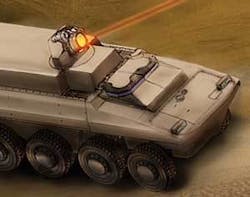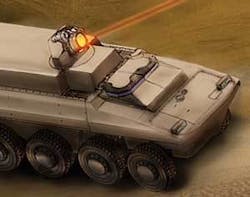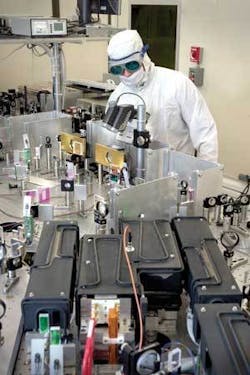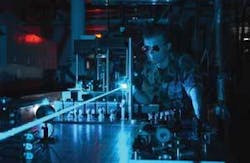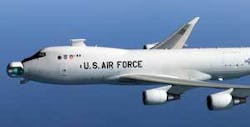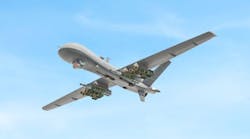Industry and military scientists are moving forward in the quest to develop solid-state lasers for use as weapons by warfighters of the future
By John McHale
Even the most casual observer of military technology is aware of the U.S. Air Force’s big-ticket program-the Airborne Laser, which eats up most of the Department of Defense funding on laser technology and is nearing completion.
Despite this high-profile large chemical laser program, however, U.S. military leaders are placing their research efforts on solid-state laser technology to get laser weaponry into the hands of the warfighter on the ground.
Solid-state lasers (SSLs) use a crystalline or glass material doped with an ion, which is the lasing species, say Northrop Grumman Space Technology experts in Redondo Beach, Calif. These lasers use flashlamps or diodes to pump the ions to excited levels, which then emit radiation. Experts have scaled these lasers to relatively high power levels for government and commercial applications.
The most common SSL is based on neodymium (Nd) doped into crystals such as yttrium aluminum garnet (YAG). Nd:YAG lasers emit radiation at 1.06 nanometers, which transmits well through the atmosphere.
Although not as powerful as their chemical counterparts, solid-state lasers are suited to defense missions such as destroying and illuminating targets for air defense, mine destruction, ship protection, and optoelectronic warfare, Northrop Grumman officials say.
“Solid-state and fiber lasers offer the potential of being more compact, thus suitable to a wider range of applications and platforms,” says Jackie Gish, director of directed energy technology at Northrop Grumman Space Technology. “With solid-state lasers, the challenge will be to make them more powerful and compact, and to dispose of and/or store waste heat compactly.”
Solid-state lasers require only electrical energy to run, which makes them easier to support than their chemical laser counterparts.
Electric lasers are the future, experts believe. Solid-state and fiber lasers offer the potential of being compact and suitable to a wide range of applications and platforms. Bulk solid-state lasers are more mature than fiber lasers, but fiber lasers offer the promise of higher efficiency.
The funding for solid-state laser technology does not touch that of the Airborne Laser and fielding is further away, but researchers are making progress.
The U.S. Army is funding the Joint High Power Solid-State Laser (JHPSSL) program to develop “military-grade,” solid-state laser technology that is expected to pave the way for the U.S. military to incorporate high-energy laser systems across all services, including ships, manned and unmanned aircraft, and ground vehicles.
JHPSSL
Two teams were selected earlier this year for Phase 3 of the JHPSSL program-Northrop Grumman Space Technology, and Textron Systems in Wilmington, Mass.
Designed to accelerate solid-state laser technology for military uses, the JHPSSL program operates on funding from the Army Space and Missile Defense Command in Huntsville, Ala; Office of the Secretary of Defense-Joint Technology Office in Albuquerque, N.M.; Air Force Research Laboratory at Kirtland Air Force Base, N.M.; and the Office of Naval Research in Arlington, Va.
Under the current phase, the program’s goal is for a laser system to reach 100 kilowatts, setting the stage for a variety of force protection and strike missions such as shipboard defense against cruise missiles; wide-area and ground-based defense against rockets, artillery, and mortars; and precision strike missions for combat aircraft. These are still laboratory lasers and fielding of an actual weapon is still years away.
“These systems promise to provide the warfighter with enhanced capability in terms of shorter engagement timelines, high-precision targeting combined with long reach, while inflicting low collateral damage,” says Jim Stamboni, senior vice president of the Textron Systems Advanced Solutions Center. These solid-state laser concepts also need to provide the warfighter with compact, affordable, and rugged directed-energy weapon systems capable of withstanding the most severe operational and environmental battlefield conditions.
“We’re anxious to move forward with scaling up to the 100 kilowatts of power in Phase 3 of the program,” says Alexis Livanos, president of Northrop Grumman Space Technology. “With parallel funding for attendant laser weapon-system technologies and demonstrations, systems using very high-power lasers could be deployed in as little as four to five years.”
Northrop Grumman’s approach uses amplifier chains assembled with several high-gain power modules. The company’s JHPSSL demonstrator used two chains to demonstrate the 27-kilowatt level achieved during Phase 2. Avoiding the need for new physics or scaling, the company’s 100-kilowatt architecture uses eight chains-similar to those used in its 27-kilowatt device.
This is the same solid-state laser technology and architecture Northrop Grumman plans for TALON, which will use a 100-kilowatt solid-state laser to shoot down rockets, mortars, and unmanned aerial vehicles (UAVs), company officials say. The laser would be mounted on a manned ground vehicle, and driving both will be hybrid electric motors.
Surpassing 25 kilowatts
Prior to Phase 3, Phase 2 of the JHPSSL program scaled bulk solid-state lasers up to stronger than 25 kilowatts, with a goal of 100 kilowatts and beyond. JHPSSL Phase 1 addressed risk reduction of the technologies necessary to obtain high power and beam quality simultaneously.
Phase 2 included laboratory demonstrations of three 25-kilowatt solid-state lasers from Northrop Grumman, Lawrence Livermore National Laboratory in Livermore, Calif., and Raytheon Missile Systems in Tucson, Ariz.
Late last year the Northrop Grumman-led team surpassed a critical milestone on the JHPSSL 2 program when its scientists demonstrated a laser system with a total power of greater than 27 kilowatts with a run time of 350 seconds. This was 110 percent of the JHPSSL program’s goals, Northrop Grumman officials say.
Several major challenges were faced by Northrop Grumman scientists in achieving 25 kilowatts, Gish says.
“We reached 25 kilowatts by combining several different technological achievements. Each one, in and of itself, was significant. First was scaling the power, or getting the most yield, from the laser materials. In this case, we use diode-pumped slabs.
“Second was developing an adaptive- optic system to produce the beam quality we needed, and third was combining multiple beams,” Gish says. The 27-kilowatt demonstration was to see how much raw power scientists could extract, regardless of beam quality.
Run time of the laser is also important. “It is basically how long the laser can fire,” Gish says. “More time on target increases lethality substantially. And it lets you shoot at a lot more threats, depending on the size of the magazine. The heat generated by the laser will not be a problem, Northrop Grumman officials say.
“Our approach to thermal management is to remove the heat in real time,” Gish says. This allows the laser to operate indefinitely. By the way, even the heat-capacity laser removes heat from the diodes in real time.
“We cool the laser by pumping coolant through the system,” Gish adds. “One of the major advantages of SSLs is that they don’t add to the logistics chain. Coolant and diesel fuel are already there. We can run as long as we have power and coolant is available.”
In a separate test, the laser demonstrated excellent beam quality at 19 kilowatts, showing how well the beam can be focused and thus get to a target.
In Phase 2, Xinetics Inc. in Devens, Mass., provided the deformable mirrors for Northrop Grumman’s laboratory demonstrator. Adaptive Optics Associates in Cambridge, Mass., developed the waveform control system. One of Northrop Grumman’s business units, Synoptics in Charlotte, N.C., supplied solid-state laser materials.
“Our demonstrator was designed as an experimental device, built with off-the-shelf hardware,” Gish says. “It wasn’t built to minimize size and weight. We have prepared designs, however, that significantly reduce size and weight.”
“The solid-state technology we’ve demonstrated will serve as the architectural foundation for a whole class of lasers that could be applied throughout much of the U.S. military,” Livanos says.
“Solid-state lasers will add new force protection and joint warfighting capabilities across military services,” says Art Stephenson, vice president of Directed Energy Systems at Northrop Grumman Space Technology. “During the past five years, through the Tactical High Energy Laser program executed in conjunction with the U.S. Army, we’ve shown the effectiveness of a high-power laser system against a variety of in-flight rockets, artillery, and mortars.
“We have also shown that the lethality of a laser results from much more than just the power level, Stephenson continues. “The laser must have good beam quality and a long run time. Our solid-state laser approach has been shown to be ‘scalable’ to high power levels without stressing the components. That’s why we believe it’s time to take high-energy lasers out of the lab and begin integrating them onto the battlefield.”
Stephenson notes that Northrop Grumman’s low-power, solid-state lasers are in daily use in the U.S. military for target designation and range finding. In addition, a Northrop Grumman solid-state illuminator laser called the Beacon Illuminator Laser, is being used for ground testing now. The Beacon Illuminator is the most powerful solid-state laser on the Airborne Laser (ABL).
The company is also under contract to build a more capable follow-on illuminator, the Strategic Illuminator Laser, which is only a few years away, he adds. Northrop Grumman also built the megawatt-class laser for ABL, the Chemical Oxygen Iodine Laser.
Research lab supporting Airborne Laser testing
Experts carried out tests involving the U.S. Air Force’s Airborne Laser’s beam control technologies, using a modified NKC-135 aircraft, earlier this year at an Air Force Research Laboratory hangar at Kirtland Air Force Base, N.M.
These tests involved low-power lasers to calibrate three special cameras mounted on the aircraft’s port wing. The cameras record the laser energy as it hits a white missile-shaped silhouette painted on the front section of the NKC-135 aircraft. From the data collected, scientists will be able to position and calibrate the cameras to collect information when this test aircraft becomes a target board for the Airborne Laser aircraft, or YAL-1A.
Later this month the cameras will be re-evaluated when the NKC-135 flies over White Sands Missile Range in New Mexico. Scientists from the laboratory’s Directed Energy Directorate, operating from the Directorate’s North Oscura Peak facilities, will fire low-power lasers in follow-on tests in more realistic operational conditions.
These low-power lasers mimic the Airborne Laser’s Beacon Illuminator Laser, Track Illuminator Laser, and High Energy Laser in wavelength, but not in power. The actual illuminator lasers are kilowatt-class, while the High Energy Laser is megawatt class.
The NKC-135 is a modified Air Force aircraft, originally derived from a Boeing 707 jetliner. This particular aircraft is called Big Crow, which has been modified for electronic warfare-related work. In past years, the Airborne Laser program used a high-altitude aircraft called Proteus for some of the early laser targeting testing.
The Missile Defense Agency’s Airborne Laser aircraft is undergoing final structural modifications at a Boeing facility in Wichita, Kan. Once that work is complete, technicians will install and ground-test the illuminator lasers there. Experts will fire the lasers into a receptacle called a Range Simulator, which will confine the beams and test the lasers’ effectiveness.
After ground testing, experts will flight-test the illuminator lasers aboard the Airborne Laser at White Sands Missile Range. A low-power laser, called the Surrogate High Energy Laser, will substitute for the weapon’s class chemical laser used by the YAL-1A. All three lasers will fire at the silhouette on the NKC-135, and three cameras will measure their performance.
The High Energy Laser, a chemical oxygen-iodine laser invented by the Directed Energy Directorate scientists in 1977, is to be installed next year, after the YAL-1A aircraft moves to Edwards Air Force Base, Calif.
TSAT laser communications development passes milestone
Laser communications experts from two U.S. defense contractors have taken the next step in their development of the future space-based military Internet called the Transformational Satellite Communications System (TSAT).
The contractor team of Lockheed Martin Space Systems in Sunnyvale, Calif., and the Northrop Grumman Space Technology sector in Redondo Beach, Calif., demonstrated the interoperability of a new fast data communications protected waveform in the initial test of the Next Generation Processor/Router (NGPR)the brain of future Internet protocol-based military satellite communications TSAT.
The test of the Northrop Grumman NGPR was done against the TSAT RF Universal System Test Terminal at Massachusetts Institute of Technology’s Lincoln Laboratory from earlier this year.
The Lockheed Martin/Northrop Grumman TSAT space segment team, which includes ViaSat, Rockwell Collins, General Dynamics Advanced Information Systems, L-3 Communications, Stratogis and Caspian Networks, is under a $514 million contract for the Risk Reduction and System Definition phase. This effort will culminate with a multi-billion-dollar development contract to be awarded to a single contractor in 2008.
Lockheed Martin Space Systems is the prime contractor, while Northrop Grumman Space Technology has responsibility for the communications payload, including laser and radio-frequency communications and on-board processing. The U.S. Air Force is managing the program at the MILSATCOM Joint Program Office, located at the Space and Missile Systems Center, Los Angeles Air Force Base, Calif.
This initial compatibility test, NGPR‑1, verified compliance with key aspects of the U.S. government’s compatibility standards for the XDR+ waveform, a secure, protected, anti-jamming waveform for TSAT ground-to-satellite uplinks and downlinks.
The tests measured the compatibility of XDR+ as well as increased bandwidth efficiency to transfer more information in the same transmitted signal bandwidth. Northrop Grumman’s NGPR operated at full-flight data rates established for TSAT, Northrop Grumman officials say.
XDR+ waveforms represent an advancement of the XDR waveform used on the Advanced Extremely High Frequency (EHF) satellite system. It meets the high-throughput requirements of TSAT, which uses radio frequency and laser communications to provide secure, efficient, global communications for warfighters. The NGPR takes the information transmitted through military user terminals, determines where the information needs to go, and selects the most efficient route based on standard commercial network design principles.
In addition to meeting planned objectives for NGPR-1, Northrop Grumman performed additional risk-reduction tests on features for the next test, NGPR-2, which will include waveform and networking capabilities. The NGPR is a critical component of TSAT, an Internet protocol-based system to provide military protected high-bandwidth communications, as well as communications-on-the-move capabilities. TSAT will network mobile warfighters, sensors, weapons and piloted aircraft in the air, on the ground, at sea, and in space.
Nufern launches two new fibers into its family of high-power triple-clad products
Nufern in East Granby, Conn., has expanded its ytterbium-doped triple clad fiber product line.
Nufern’s new PM-YTF-5/105/125 and PLMA-YTF-30/300/330 offer geometries and properties that complement the previously released PLMA-YTF-20/300/330 and LMA-YTF-22/400/480 triple clad fibers, Nufern officials say. Designed with the PANDA stress structure, these polarization maintaining ytterbium-doped fibers introduce an additional layer of glass around the second or “pump cladding” to contain pump light.
Using this “glass-on-glass” construction enables higher-temperature operation and allows for easier splicing to fiber pigtailed pumps, company officials say. Triple-clad all glass fibers also offer mechanical advantages when free space coupling of signal and pumps is required. The hard outer cladding allows for the use of standard ferrule assemblies, which enables precise alignment of the injected seed signal.
“These new additions to our family of triple-clad fibers offer our customers a wider range of fiber geometries from which to choose,” says Bryce Samson, vice president of business development at Nufern. “The combination of the triple clad structure and large mode area technology allow our customers enhanced reliability and performance in the design of high power fiber lasers and amplifiers.”
In other areas, Nufern engineers released an entirely new line of fibers, called NuWIRE, that is designed to address the harsh environmental conditions experienced in communication and sensor applications.
“These fibers are designed to have long life (22 years, for continuous operation at 125 degrees Celsius) and deliver outstanding performance in applications where temperature variations may be large and rapid, and shock stress and vibration are routine,” says Carl Crossland, product marketing manager.
NuWIRE fibers come with either Nufern’s High Temperature Acrylate (HTA) silicone or polyimide coatings. The NuWIRE family of products consists of multimode and single mode fibers.
Nufern offers fiber intensive subassemblies and specialty optical fibers for diverse industries. For more information visit www.nufern.com.
